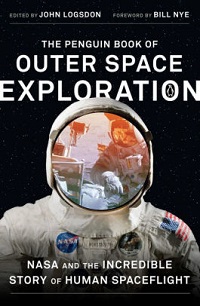Beyond the Stars | Science & Technology Reviews
 The Penguin Book of Outer Space Exploration: NASA and the Incredible Story of Human Spaceflight. Penguin. Sept. 2018. 416p. ed. by John Logsdon. illus. notes. ISBN 9780143129950. pap. $18; ebk. ISBN 9781101993491. SCI
The Penguin Book of Outer Space Exploration: NASA and the Incredible Story of Human Spaceflight. Penguin. Sept. 2018. 416p. ed. by John Logsdon. illus. notes. ISBN 9780143129950. pap. $18; ebk. ISBN 9781101993491. SCI
Logsdon has studied space exploration since his doctoral dissertation in the late 1960s. As founder of the Space Policy Institute, he edited the seven-volume work on the history of the U.S. Civil Space Program, on which this new volume is based in part; it also expands on 2015’s After Apollo? Richard Nixon and the American Space Program. The author clearly knows and is inspired by his material, and his enthusiasm comes through here. However, there are limitations in a condensed volume, such as how some points are not precisely accurate when summarized; for example, the Jet Propulsion Lab did not specifically replace Caltech’s GALCIT operation. Nevertheless, the reprinting of key documents, including astronaut John Glenn’s “Brief Summary of MA-6 Orbital Flight” makes for a fascinating read. The author suggests this book be read, not referred to for reference; however, it could function as a basic reference in undergraduate or public library collections.
VERDICT An absorbing read for space exploration enthusiasts, from high schoolers to adults.—Sara R. Tompson, Jet Propulsion Laboratory Lib., Pasadena, CA
Launius, Roger D. The Smithsonian History of Space Exploration: From the Ancient World to the Extraterrestrial Future. Smithsonian. Oct. 2018. 400p. photos. ISBN 9781588346377. $40. SCI
Launius (former associate director, Collections and Curatorial Affairs, Smithsonian Air and Space Museum) lends his expertise to this comprehensive history of space exploration. In the first chapter, the author briefly examines space discoveries from ancient times to the 1930s. In the remaining sections, he covers the period from World War II onward, when space exploration accelerated dramatically; in particular, technological advances in rocketry, which increased rapidly during the war, especially in Germany. After the conflict, Nazi scientists and equipment were captured by the Allies and then brought to both the United States and the Soviet Union resulting in the space race. This competition between the two superpowers led to advances such as the first satellite, the first manned space mission, and the moon landing. The author also examines the space programs of China, Japan, Great Britain, and elsewhere. He speculates about lunar tourism, humans on Mars, and the pursuit of interstellar space exploration. Furthermore, Launius recognizes the impact of space exploration on popular culture in sf books and movies.
VERDICT A recommended introduction to space exploration, this readable history is further supplemented with sidebars, historical photographs, and charts.—Dave Pugl, Ela Area P.L., Lake Zurich, IL
RELATED
ALREADY A SUBSCRIBER? LOG IN
We are currently offering this content for free. Sign up now to activate your personal profile, where you can save articles for future viewing









Add Comment :-
Comment Policy:
Comment should not be empty !!!